New Embedded Picture Mnemonics now available
11 Replies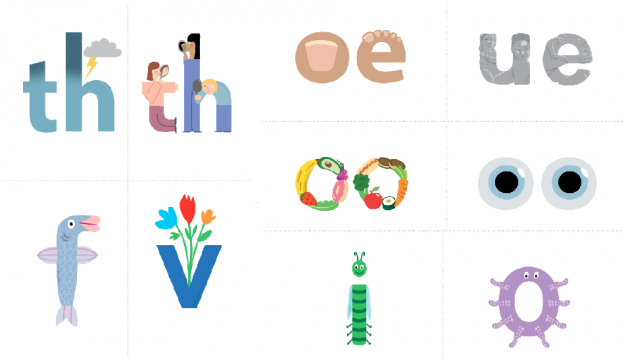
Despite a universe determined to throw spanners in my works, I’ve finally put artist Cat MacInnes’ new, improved version 2 Embedded Picture Mnemonics into the Spelfabet website shop. If you already bought version 1, you can now upgrade for free.
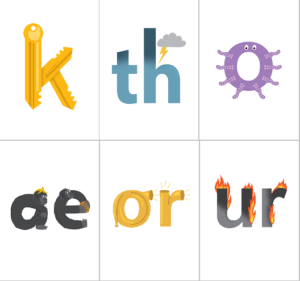 Research has shown embedded picture mnemonics help children learn the relationships between speech sounds and letters.
Research has shown embedded picture mnemonics help children learn the relationships between speech sounds and letters.
There are now two versions of the Spelfabet Embedded Picture Mnemonics: one for speakers of Australian/British (non-rhotic) English, and one for speakers of American (rhotic) English. If you speak another version of English, download both files and mix and match to suit your accent.
Each set contains a mnemonic for each sound (phoneme) plus one for each of the three letters that represent the same sound as c (k, q, x). The pictures are now more relevant outside Australia, with k as in ‘key’ not ‘kangaroo’, ur as in ‘burn’ not ‘surf’ and u as in ‘up’ not ‘undies’ (I’m a little sad about the undies, so if you are too, just keep using the original mnemonic).
The sets now contain ‘o’ as in ‘octopus’, ‘ue’ as in ‘statue’, ‘or’ as in ‘horn’, ‘th’ as in ‘thunder’ and ‘themselves’, and ‘f’ as in ‘fish’ (no adjacent consonant). There are new ‘aw’ as in ‘claw’ and ‘wh’ as in ‘whale’ mnemonics in the US set. The relationship between ‘short’ and ‘long’ vowels is now clearer, as the ‘long’ vowels have a consistent format (ae, ee, ie, oe, ue).
Both the Aust/UK and US A4 poster size files can be found here. The pictures on them are now bigger, with less white space around them.
Both the Aust/UK and US A4 flashcard size files (four to a page) are here. Consonants are in portrait format and the vowels are in landscape format, which I hope helps children understand the difference between vowel and consonant sounds.
You can make and change words with these embedded picture mnemonics, using the flashcard size with individuals and small groups, like this:
Use the poster size mnemonics if doing this with a whole class, asking a child to hold each mnemonic you’ve taught and another child to rearrange them, while the rest of the class writes down the words thus created.
You can also use the mnemonics to build Sound Walls with your class, adding sounds and/or spellings as they are taught in your phonics teaching sequence, and refreshing the wordlists as new vocabulary is learnt, so that you might end up with mnemonics that look like this:

Teachers, therapists and others have already thought of lots of other great ways to use these mnemonics – too many to list here.
Thanks for the feedback and questions about version 1, which made me think about how to improve them. I hope you like Version 2, and thanks to the always-creative Cat MacInnes for her artistic talent, patience and hard work.
Steps for upgrading a previously-purchased file:
1. Go to the Spelfabet website and click on My Account.
2. Type in the email address you used for your original purchase, and the password you created. If you can’t remember your password, just reset it.
3. Go to the downloads area, click on the file(s) you want, and save it/them to your computer before printing. Ordinarily you get three chances to download any file from the online shop, in case of computer crashes or power outages, but I’ve increased this to four for these files in case some previous purchasers have used up their first three.
Any feedback or problems, email me on info@spelfabet.com.au.
Another 12 decks of vowel-focussed playing cards
2 Replies
Just in time for our thank-goodness-winter-is-over school holidays, here’s a dozen more vowel-sound-focussed playing card decks, including two freebies, to download and print.
These decks are a little more advanced than the previous ones available here, here and here. They reflect the teaching sequence used in the Phonic Books Talisman 1/Rescue Series and the Sounds-Write program‘s Extended Code section and books, but can be used with other synthetic phonics teaching sequences and programs.
The decks work from sound to print, and focus on the following sound-spelling relationships:
- /ay/ as in “mistake”, “contain”, “holiday”, “navy”, “obey” and “great”.
- /ee/ as in “coffee”, “disease”, “secret”, “carry”, “believe”, “protein” and “compete”.
- /oe/ as in “remote”, “roast”, “follow”, “hero” and “mangoes”.
- /er/ as in “swerve”, “circle”, “burnt”, “search” and “worth”.
- /ou/ as in “aloud” and “trowel”, and /oy/ as in “point” and “destroy”.
- /oo/ as in “smooth”, “rule”, “true”, “fluid”, “jewel” and “group”.
- /igh/ as in “delight”, “despite”, “crisis”, “apply” and “allies”.
- /or/ as in “porch”, “before” and “drawn”.
- /or/ as in “stall”, “chalk”, “brought”, “daughter”, “author” and “warm” (there were so many spellings of this sound they wouldn’t fit in a single deck).
- /air/ as in “chair”, “declare”, “bear”, “where” and “their”.
- /ar/ as in “charm”, “past”, “calm”, “heart” and “aunt”.
- One deck of high-frequency words with a mixture of the above sound-spelling relationships (not available separately, but included to bring this set up to a dozen decks).
The decks can be downloaded individually (starting from the third item here) or as a discounted bundle of 12. We suggest printing the cards on A4 200gsm cardboard, available from major stationery shops, which can be used in most printers/photocopiers.
If you plan to use the cards a lot, we suggest laminating them, though this is not essential if you’d rather not add to the planetary plastic overload. We recommend that children be encouraged to practise their scissor skills by cutting them up, rounding the corners if a more professional look is sought.
All the decks can be used for any card game requiring a standard deck of cards, from very simple games of chance like War to complex strategic ones like Mancala. See this previous blog post for videos of other suggested games.
We hope these cards give many children many hours of well-targeted, high-intensity repeated reading practice, cleverly disguised as fun. Thanks once again to Caitlin Stephenson for the original idea and design.
Free early phonemic awareness, phonics and handwriting workbook
10 Replies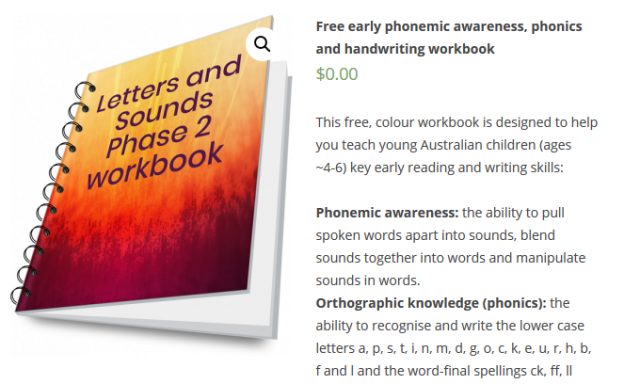
Last week, I read my state education department’s booklet advising parents on how to help children with literacy and numeracy. I understand it will be in the Prep bags given to all Victorian children starting school in 2019.
I was, frankly, appalled. The booklet mentions phonics only once, saying onscreen phonics games improve reading and “letter sound awareness”, whatever that is. It doesn’t mention phonemic awareness or handwriting at all.
A ton of scientific research has shown that phonemic awareness and phonics are key ingredients in getting literacy beginners off to a good start, along with work on vocabulary, comprehension and fluency, and that writing letters helps you remember them. (more…)
Free Learning Difficulties Including Dyslexia webinars
8 Replies
La Trobe University and the Victorian Department of Education have this year collaborated to run workshops across Victoria about learning difficulties including dyslexia. The workshops have been available to teachers and other Department of Education staff.
The information from these workshops is now being made available free online via YouTube as webinars. Wow. Amazingly generous of both the University and the Department, since most professional development of this type and quality is paywalled. So thanks to all involved.
The webinars are presented by Dr Tanya Serry from La Trobe University, and the workshops on which they are based were developed with Professor Pamela Snow, Ms Emina McLean and Assistant Professor Jane McCormack also from La Trobe, and Dr Lorraine Hammond from Edith Cowan University in WA. (more…)
Phonemes are sounds AND articulatory gestures
20 Replies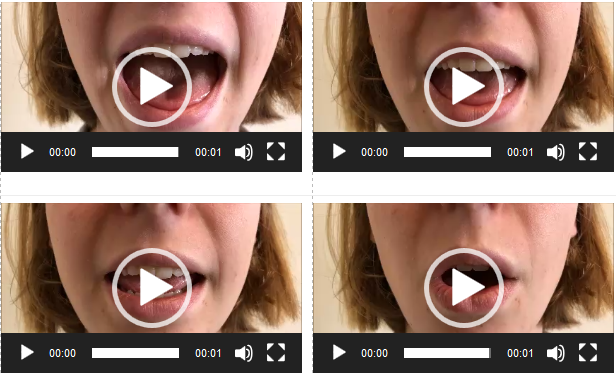
Phonemes are perceptually distinct speech sounds that distinguish one word from another, e.g. the “p”, “b”, “t” and “d” in “pie”, “by”, “tie” and “die”. They’re also articulatory gestures.
A 2009 article co-authored by reading guru Linnea Ehri says “awareness of articulatory gestures facilitates the activation of graphophonemic connections that helps children identify written words and secure them in memory.” Melbourne Speech Pathologist Helen Botham (Hi, Helen!), lists a number of references on her Cued Articulation website indicating articulatory awareness facilitates phonemic awareness.
I sit right across the table from my clients, so we can see and hear each other’s articulation well. It must be a lot harder to teach a whole class about phonemes, in order to link them to graphemes. Videos on the internet (including my own) about phonemes seem to put them all in one video, making them hard to isolate and repeat on a classroom interactive whiteboard.
I’ve thus filmed my utterly adorable and orthodontically photogenic niece Vivien (thanks, Vivien!) saying each phoneme separately. The 44 videos are below, each with example words which link to the relevant spelling lists on my website. (more…)
Free spelling lists for teachers
6 Replies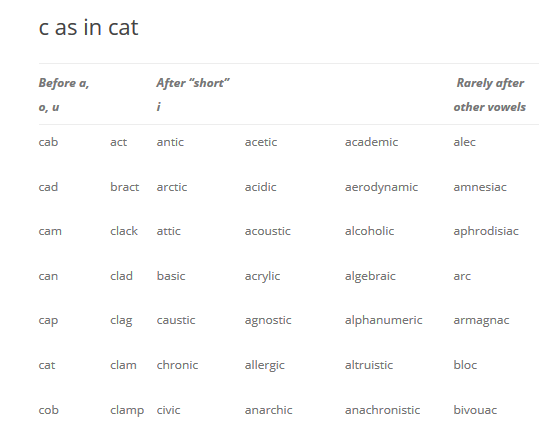
One of my fun summer activities has been refreshing and editing the free spelling lists on my website (yeah, weird, I know).
I hope teachers find them useful when teaching spelling, I know some already do. Other free spelling lists on the internet tend to focus on what words look like, but not what they sound like, or how they’re constructed, or they tend to reflect UK or US accents, not Australian English.
My lists menu allows words to be looked up in three different ways:
- Starting from sounds (phonemes) and looking up their spellings (graphemes). This is the direction we need to work in for spelling, i.e. turning speech into print.
- Starting from spellings and looking up the sounds they represent, which is the reading direction i.e. turning print into speech (whether reading aloud or silently).
- Starting with short, simple words and working towards longer, more complex ones, the direction needed for teaching. This sequence is the one used in my workbooks, but it’s not better than any other sequence. The important thing is to have a sequence. If wanting to use this one, but not sure where to start, my free low-frequency word spelling test might help.
What’s the difference between short and long vowels?
23 Replies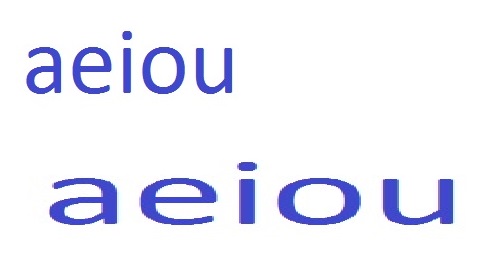
Phonics teaching materials often talk about "short" and "long" vowels, as though the latter are just extended versions of the former.
The five vowels usually called "short" are:
- "a" as in "cat",
- "e" as in "red",
- "i" as in "sit",
- "o" as in "not",
- "u" as in "bus".
The five vowels usually called "long", and which children are told "say their (letter) name", are:
- "a" as in "paper",
- "e" as in "be",
- "i" as in "find",
- "o" as in "go",
- "u" as in "human".
But are we talking about sounds here, or particular spellings of these sounds?



